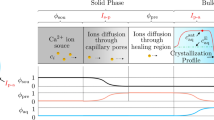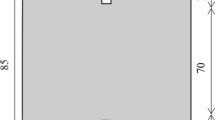Abstract
Crack healing experiments were conducted at 780°, 815°, and 850° C in dry carbon dioxide over periods of 0.5 to 1320 h on small penny-shaped cracks of known geometry in Stahl calcite. As observed by previous investigators, healing initiates with the formation of tubes around the leading edge of the crack, followed by the pinching off of spherical bubbles from these tubes. Pillars and peninsular structures formed and grew at cleavage steps and other surface irregularities, greatly accelerating the healing process in some cracks. The crack tip regression distance at constant temperature follows a simple power law in time; although, with the exception of one crack at 850° C, the time exponent systematically decreases from 0.59 at 780° C to 0.15 and 0.07 at 815° and 850° C, respectively. Only the largest exponent is consistent with existing theory: the two smaller time exponents are, as yet, unexplained. Healing rates are strongly inversely dependent upon crack aperture, in qualitative agreement with theory. For example, cracks with maximum apertures of less than 60 nm (6×10−8 m) healed completely in 0.5 to 25 h at 850° C; while fatter cracks, with maximum apertures of about 700 nm, showed very little healing after up to 1320 h at the same temperature. At 780° C, the functional dependence of healing rate upon crack aperture was consistent with several aspects of the present model.
Similar content being viewed by others
References
Bandyopadhyay G, Roberts JTA (1976) Crack healing and strength recovery in UO2. J Am Ceramic Soc 59:415–419
Bonzel HP (1973) Surface Diffusion of Metals. In: Shimodaira S, Maeda M, Okamoto G, Onchi M, Tamai T (eds) Structure and Properties of Metal Surfaces. Maruzen Company, Ltd, Tokyo, pp 248–328
Brace WF (1977) Permeability from resistivity and pore shape. J Geophys Res 82:3343–3349
Brace WF, Orange AS, Madden TR (1965) The effect of pressure on the electrical resistivity of water-saturated crystalline rocks. J Geophys Res 70:5669–5678
Dynys JM (1982) Sintering mechanisms and surface diffusion for aluminum oxide. PhD Thesis, Massachusetts Institute of Technology
Evans AG, Charles EA (1977) Strength recovery by diffusive crack healing. Acta Metall 25:919–927
Gilman JJ (1960) Direct measurements of the surface energies of crystals. J Appl Phys 31:2208–2218
Gupta TK (1975) Crack healing in thermally shocked MgO. J Am Ceramic Soc 58:143
Gupta TK (1976) Kinetics of strengthening of thermally shocked MgO and Al2O3. J Am Ceramic Soc 59:448–449
Gupta TK (1978) Instability of cylindrical voids in alumina. J Am Ceramic Soc 61:191–195
Hadley K (1976) Comparison of calculated and observed crack densities and seismic velocities in Westerly Granite. J Geophys Res 81:3484–3494
Hay RS (1987) Chemically induced grain boundary migration and thermal grooving of calcite bicrystals. Ph.D. Dissertation, Princeton University, Princeton, New Jersey
Herring C (1951) Some theorems on the free energies of crystal surfaces. Phys Rev 82:87–93
Janczuk B, Chibowski E, Staszczuk P (1983) Determination of surface free energy components of marble. J Colloid Interface Sci 96:1–6
Johnston J (1910) The thermal dissociation of calcium carbonate. J Am Chem Soc 32:938–946
Lange FF, Clarke DR (1982) Morphological changes of an intergranular thin film in a polycrystalline spinel. J Am Ceramic Soc 65:502–506
Loveland RP (1970) Photomicrography; a comprehensive treatise. John Wiley, New York (2 vols)
Markgraf SA, Reeder RJ (1985) High-temperature structure refinements of calcite and magnesite. Am Mineral 70:590–600
Mirwald PW (1976) A differential thermal analysis study of the high-temperature polymorphism of calcite at high pressure. Contrib Mineral Petrol 59:33–40
Morrow CD, Lockner D, Moore D, Byerlee J (1981) Permeability of granite in a temperature gradient. J Geophys Res 86:3002–3008
Nichols FA (1976) Spheroidization of rod-shaped particles of finite length. J Mater Sci 11:1077–1082
Nichols FA, Mullins WW (1965a) Morphological changes of a surface of revolution due to a capillarity-induced surface diffusion. J Appl Phys 36:1826–1835
Nichols FA, Mullins WW (1965b) Surface (interface) and volume diffusion contributions to morphological changes driven by capillarity. Trans AIME 233:1940–1948
Pecher A (1981) Experimental decrepitation and re-equilibration of fluid inclusions in synthetic quartz. Tectonophysics 78:567–583
Richter D, Simmons G (1977) Microcracks in crustal igneous rocks: Microscopy. In: Heacock JG (ed) The Earth's Crust, Geophysical Monograph 20. Am Geophys Union, Washington, D.C, pp 149–180
Roberts JTA, Wrona BJ (1973) Crack healing in UO2. J Am Ceramic Soc 56:297–299
Roedder E (1984) Fluid Inclusions. Mineralogical Society of America, Reviews in Mineralogy 12
Shelton KL, Orville PM (1980) Formation of synthetic fluid inclusions in natural quartz. Am Mineral 65:1233–1236
Shewmon PG (1983) Diffusion in Solids. J Williams Book Co, Jenks, Oklahoma
Shirey SB, Simmons G, Padovani ER (1980) Angular, oriented microtubes in metamorphic plagioclase. Geology 8:240–244
Smith DL, Evans B (1984) Diffusional crack healing in quartz. J Geophys Res 89:4125–4135
Sneddon IN (1946) The distribution of stress in the neighborhood of a crack in an elastic solid. Proc Roy Soc London, A 187:229–260
Sprunt ES, Nur A (1979) Microcracking and healing in granites: new evidence from cathodoluminescence. Science 205:495–497
Vaughan PJ, Moore DE, Morrow CA, Byerlee JD (1986) Role of cracks in progressive permeability reduction during flow of heated aqueous fluids through granite. J Geophys Res 91:7517–7530
Walsh JB (1965) The effects of cracks on the compressibility of rock. J Geophys Res 70:381–389
Wanamaker BJ, Evans B (1985) Experimental diffusional crack healing in olivine. In: Schock RN (ed) Point Defects in Minerals, Geophysical Monograph 31. Am Geophys Union, Washington, D.C, pp 194–210
Yen CF, Coble RL (1972) Spheroidization of tubular voids in Al2O3 crystals at high temperatures. J Am Ceramic Soc 55:507–509
Author information
Authors and Affiliations
Rights and permissions
About this article
Cite this article
Hickman, S.H., Evans, B. Influence of geometry upon crack healing rate in calcite. Phys Chem Minerals 15, 91–102 (1987). https://doi.org/10.1007/BF00307614
Received:
Issue Date:
DOI: https://doi.org/10.1007/BF00307614




